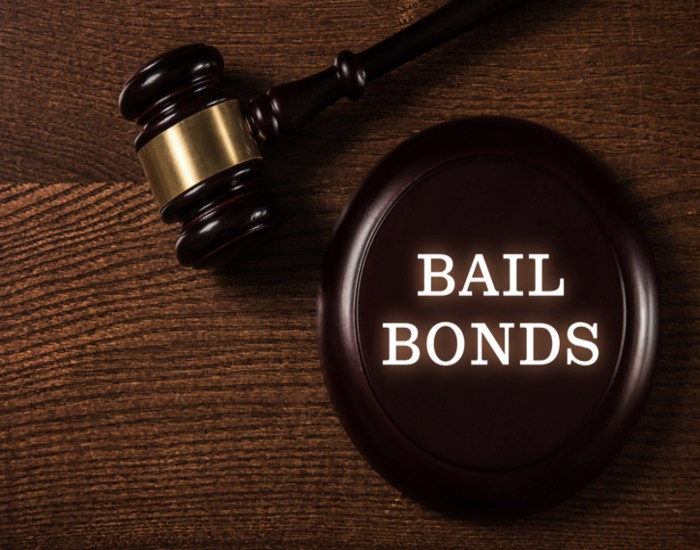Understanding the Conveniences of Bail Bonds Mansfield Ohio for Your Scenario
Understanding the Conveniences of Bail Bonds Mansfield Ohio for Your Scenario
Blog Article
The Function of Bail Bonds in Guaranteeing a Fair and Efficient Judicial Process
The role of bail bonds in the judicial process is multifaceted, touching on problems of fairness, performance, and financial variation. While they supply a critical mechanism for offenders to secure pretrial release, bail bonds additionally raise crucial inquiries about equality and justice.
Recognizing the Bail System
Browsing the ins and outs of the bail system is crucial for understanding how individuals accused of criminal offenses are temporarily launched from safekeeping while waiting for test. At its core, the bail system is made to ensure that an implicated person returns for court looks while allowing them to preserve their day-to-day live throughout the meantime. The procedure starts as soon as an offender is billed and brought in the past a court, that determines the bail quantity based upon variables such as the extent of the claimed offense, the defendant's criminal background, and possible trip threat.
Bail can take different forms, including cash bonds, residential property bonds, and guaranty bonds. A money bond needs the full bail quantity to be paid in advance, which is refunded upon case resolution. Residential or commercial property bonds involve pledging substantial properties as collateral. Surety bonds, frequently facilitated by bail bond representatives, permit accuseds to pay a percentage of the bail quantity, with the agent providing an economic warranty to the court.

Lawful Framework and Regulations
The lawful framework and regulations regulating the bail system often play a pivotal function in shaping its application and justness. These lawful constructs are mostly focused on balancing the interests of the accused, the sufferers, and society. Statutory stipulations, situation legislation, and procedural policies collectively develop the structure upon which the bail system operates. When setting bail., secret regulation such as the Bail Reform Act establishes out guidelines that figure out qualification, conditions, and elements thought about by courts.
Judicial discernment is one more foundation of the bail procedure, equipping judges to analyze the subtleties of each case. This discretion is directed by a series of statutory variables, consisting of the severity of the infraction, flight risk, and potential threat to the area. In addition, guidelines commonly give for various sorts of bail, such as cash money bail, surety bonds, and release on recognizance, each with distinctive needs and effects.
Moreover, reforms over the last few years have looked for to resolve systemic injustices, such as financial variations and racial biases, influencing bail choices (best bail bonds mansfield ohio). These reforms aim to improve the fairness of the judicial procedure, ensuring that the lawful structure adapts to contemporary social needs while preserving public security and due procedure
Effect on Defendants' Legal Rights
While the bail system is created to make sure both the accused's appearance at test and the security of the area, it considerably influences accuseds' civil liberties, especially when defalcated or affected by inequitable elements. At its core, the need for bail can weaken the assumption of innocence, an essential concept of justice. Defendants who can not pay for bail may deal with long term pretrial detention, which can bring about loss of family members, housing, and work interruption, consequently affecting their capacity to install an effective defense.
Additionally, the bail system can aggravate existing inequalities. Those with minimal funds might be persuaded into begging guilty to minimal costs to expedite release, regardless of their real sense of guilt or virtue. This dynamic increases worries regarding the justness and stability of the judicial procedure, as it might oblige individuals to decriminalize decisions based on economic restraints as opposed to the values of their case.
Additionally, the psychological influence of pretrial apprehension can harm an accused's psychological health and wellness and decision-making capacity, further infringing on their rights. The system's dependence on monetary bail often fails to take into consideration different procedures, such as electronic surveillance or area supervision, which could stabilize public security with supporting accuseds' rights.
Economic and Social Factors To Consider

From a wider social viewpoint, the bail system adds to bigger societal inequalities. Neighborhoods with high prices of pretrial apprehension experience increased instability, as individuals that can otherwise contribute favorably to their areas find themselves entangled in the justice system. This phenomenon can sustain cycles of destitution and criminal offense, threatening public safety Website and community cohesion.
Additionally, the financial implications prolong beyond private offenders, as taxpayers birth the costs of keeping overcrowded detention facilities. This increases concerns concerning the appropriation of public resources and the effectiveness of such expenditures in achieving justice - bail find this bonds near me mansfield ohio. Addressing these social and financial factors to consider is essential for a more fair judicial procedure that focuses on both justness and effectiveness in its operations
Challenges and Reform Efforts
Browsing the obstacles of the bail system exposes a complicated web of legal, social, and economic concerns that demand comprehensive reform efforts. At the heart of these obstacles is the difference in just how bail affects individuals based on their financial standing. The existing system often overmuch influences low-income accuseds who are unable to afford bail, leading to long term pretrial apprehension. This not only threatens the anticipation of innocence yet likewise adds to jammed jails and increased taxpayer worries.
Reform efforts are obtaining momentum, with an emphasis on creating a much more equitable system. Territories throughout the United States are exploring choices such as danger analysis tools that evaluate an accused's likelihood to fail or reoffend to appear in court. These devices intend to replace money bail with non-monetary problems of launch. Additionally, some states are carrying out legal changes to limit or remove money bail for non-violent offenses.
Nonetheless, these reforms are consulted with criticism and challenges, especially worrying the precision and justness of threat analyses and potential biases. Successful reform requires collaboration among policymakers, lawyers, and area stakeholders to guarantee that the modifications promote justice without compromising public security.
Conclusion

Guaranty bonds, typically facilitated by bail bond representatives, allow offenders to pay a portion of the bail amount, with the agent supplying a financial assurance to the court.
Key regulation such as the Bail Reform Act establishes out guidelines that figure out eligibility, conditions, and elements taken into consideration by courts when setting bail.
Additionally, policies typically give for various types of bail, such as money bail, surety bonds, and release on recognizance, each with unique demands and effects.
While the bail system is designed to ensure both the accused's appearance at test and the safety and security of the neighborhood, it dramatically influences offenders' civil liberties, specifically when defalcated or influenced by inequitable elements.The bail bond system plays a critical function in balancing the judicial procedure by giving economic systems that assist in accuseds' release while waiting for test.
Report this page